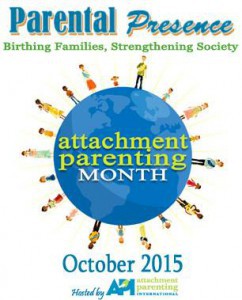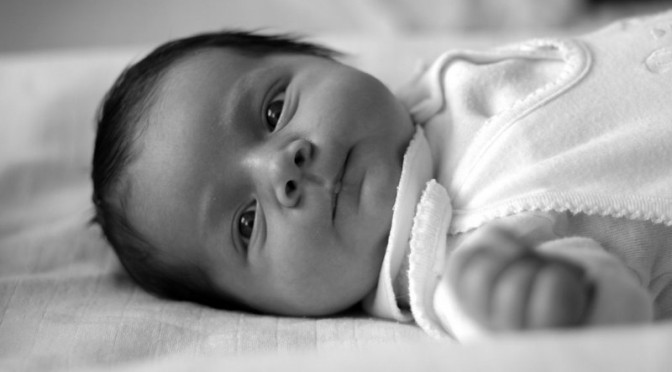 So what are the essential experiences that an infant needs to set their primary attachment figure apart from their other secondary ones? Rapid response to crying and initiating social play are the 2 experiences that are the greatest promoters of attachment behavior during the first 7 months. This would normally lead the baby to develop a primary attachment bond with the person the baby experiences as most involved in these activities. This does not depend either on the location of these experiences, or whether the adult and baby are related to each other, and they don’t have much to do with the day-to-day physical needs of the baby.
So what are the essential experiences that an infant needs to set their primary attachment figure apart from their other secondary ones? Rapid response to crying and initiating social play are the 2 experiences that are the greatest promoters of attachment behavior during the first 7 months. This would normally lead the baby to develop a primary attachment bond with the person the baby experiences as most involved in these activities. This does not depend either on the location of these experiences, or whether the adult and baby are related to each other, and they don’t have much to do with the day-to-day physical needs of the baby.
About the Author
Sir Richard Bowlby, Bt, serves on Attachment Parenting International‘s Advisory Board. He is the son of the late John Bowlby, a psychology researcher best known as the father of Attachment Theory, which serves as the scientific foundation of Attachment Parenting. Sir Richard carries on his father’s work by giving lectures to both healthcare professionals and the general public on the significance of Attachment Theory in relationships. He has a particular concern about the psychological impact on babies and toddlers in daycare.
The period that a baby uses to select a primary attachment figure stretches from 2 to over 12 months, with most infants making up their minds in the period between 3 and 7 months.
The baby will focus on the person who is most often there for them when needed and who most often gets it right. The person who has learned best to tune in to their emotional state and gives them joy, the person most sensitive to their needs and whose behavior the baby has learned to predict most reliably will ultimately become the primary attachment figure.
As my father — John Bowlby — put it, the primary attachment will be established with “the one person who steadily ‘mothers’ the baby.”
How Babies Attach
- 0 to 3 Months — A baby is born with a number of functioning behavioral systems that will form the building blocks of later attachment behavior, such as crying, clinging, looking and sucking; and then a few weeks later, they’re smiling and babbling, as well. From birth, babies have good hearing and sense of smell, which is how they discriminate one person from another, and they respond more favorably to a human voice, to a human face and to human touch than to other such stimuli. Newborn babies may develop a preference for a familiar person to care for them early on. However, for the first 2 or 3 months the infant has not developed proper attachment behavior and his attempts at social interaction are primitive.
- 3 to 7 Months — After 3 months, babies begin to differentiate between the people around them and they become selective about who they “socialize” with most. This period, until 7 months, is when the babies work out who’s who in their lives and increasingly select 1 person. It’s during this phase that most infants are in a high state of sensitivity for developing attachment behavior toward a “mother figure,” and her lively and sensitive response to the baby’s signals and approaches for interaction will be very important.
- 7 to 12 Months — When 7 months old, most infants become increasingly discriminating in the way they treat people and have a repertoire of responses, including following a departing mother
figure, greeting her on her return and using her as a base from which to explore. Although the rather indiscriminate friendly response to everyone else diminishes, certain people are selected to become secondary attachment figures. The beginnings of attachment behavior may be delayed until after the first birthday in some babies who have little contact with their main attachment figure.
What Determines Primary or Secondary Attachment
The more readily the mother responds to his cries and the more interaction she initiates, the more strongly her infant will tend to be attached to her at 18 months old.
But there are other important interactions. For instance, when an infant is distressed, bodily contact seems vital, whether it’s to soothe a crying infant during the early months or, when he’s a bit older, to comfort him when he’s frightened.
Regular rituals, especially those associated with nighttime parenting, seem important when establishing the primary attachment bond. Feeding, bathing, being put to bed, being
comforted during the night, waking up in the morning and getting dressed are all interactions when an infant has the opportunity to assess the availability, sensitivity, responsiveness and
commitment of their carer.
Schaffer and Emerson write about the development of attachment bonds in a study of 58 children in Scotland. They reported that some mothers who were available all day were not responsive or sociable with their infants, whereas some fathers who were not frequently available interacted strongly with their infants whenever they were with them. In such families, a child tended to become more intensely
attached to father than to mother.
Schaffer and Emerson explain: “Several of the mothers complained their policy of not spoiling was being ruined by their husbands, and the infant who was quite undemanding as long as only the mother was about, would make intense demands for his father’s presence and attention during holiday periods, weekends and evenings. … One child whose mother was in full-time work chose Grandmother [as his primary attachment figure] who looked after him most of the day.”
Writing about secondary attachment figures, Schaffer and Emerson reported: “Father was the most frequent other figure to elicit attachment behavior. Next in frequency were older children, not only very much older children … but also preschool children. We found no evidence that attachment to mother was less intense when attachment behavior was directed to other figures. On the contrary, in the early months of attachment, the greater number of figures to whom a child was attached, the more intense was his attachment to his mother as his principal figure likely to be.”
The person who measures up second-best will usually become the most significant secondary attachment figure. However, it takes time for a baby to form secondary attachment bonds and assess other people’s attributes, and unless there are regular and prolonged opportunities to interact with them, the secondary attachment bond will have little substance. Well-developed
secondary attachment bonds are a great safety net for a child if anything should befall their primary attachment figure or if they become emotionally or physically unavailable.
Sibling Attachments
For most people, the longest attachment relationship they will ever have in their life is with a sibling, and it’s normally a secondary attachment, but it can be primary. The duration of a sibling
relationship is usually longer than with parents, grandparents, nanny or even a partner. Family bonds, whether primary or secondary, can be a great support and last over several generations, especially if regular contact is maintained. A particular case in point is twins, with identical twins — and especially conjoined twins — well known for their intense and often devoted lifelong bonds.
Broken Attachments
Children only have a limited amount of resilience, and making new secondary attachment bonds only to have them broken again is very troubling. However, with care and discretion, it’s not too difficult for a child to separate from a secondary attachment figure — certainly far less difficult compared to separating from a primary one! But the more often any attachment bond is broken, the harder it becomes for the child.
However valuable secondary attachment figures are, the child will have a unique emotional intensity with their primary attachment figure throughout their life. The decisions of how to use this knowledge, I leave up to you. I cannot pretend to make your decisions easier, but I think we must give proper weight to this scientifically rigorous body of research work when we consider care arrangements for very small babies and young children.
*Top photo source: Free Images.com/Sona Psotova


This seems to describe imprinting. Attachment is so inferior to prenatal and infant bonding with mother. Adoption myths and marketing, laws and policies strip adoptee’s of this human right and identity.
When the mother is the primary attachment figure, and after a year she needs to go back to work a few days a week.. Is that frequently breaking an attachment bond? Can the primary attachment change to the caregiver on those days, i.e. grandpa?
Cause when she just turned 1 I have to go back to work. But I’m considering to postponing until she’s 2. I don’t want to panic her when I suddenly leave for days after a year of fulltime mothering. It feels like I will ruin the bond we have build now. She is 5 months but already obviously very attached to me, since she often starts crying when I am not the one holding her.
Attachment Parenting International recognizes that, in many homes, both parents work. Placing your child with a loving, consistent caregiver who is knowledgeable about attachment and understands the importance of your child forming an attachment to her/him, as well as your loving daily reconnection and home life when you are not at work, will go a long ways toward protecting your child’s attachment when you decide to return to work.
This article was very helpful whether you have a baby in your life or not because it helps you to be prepared. At least people can now understand the baby’s responses and why they choose to attach to one person and not the other. I like how you included the different ages and how babies respond accordingly.